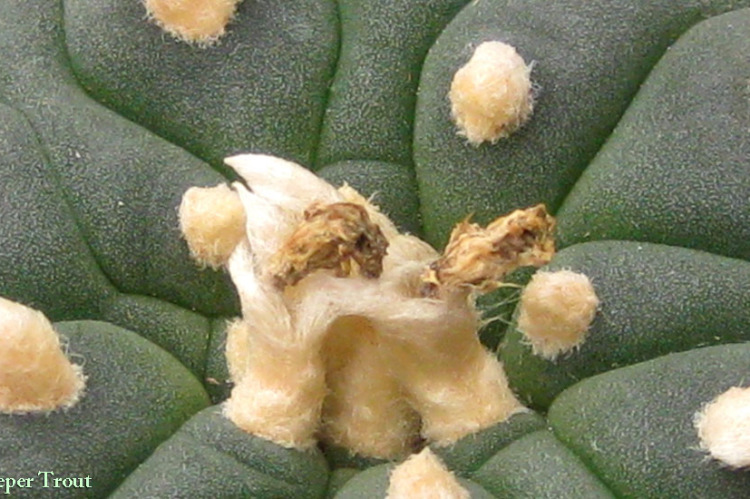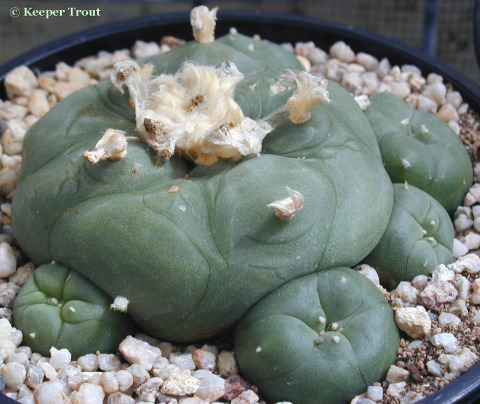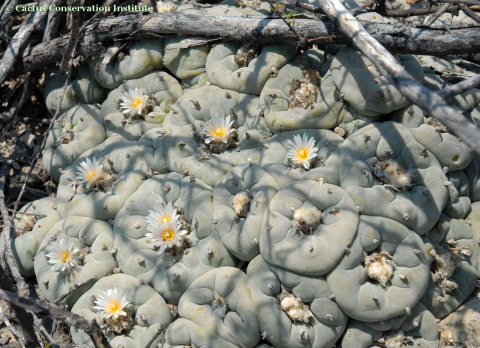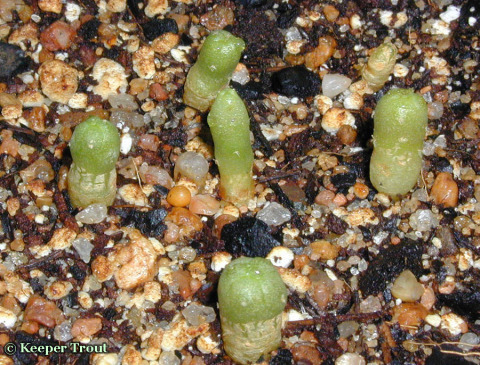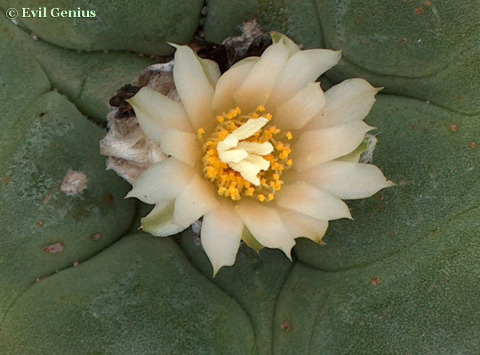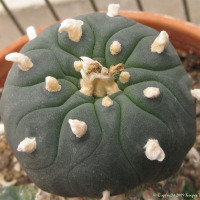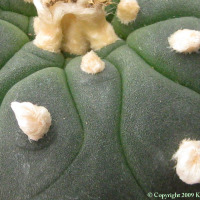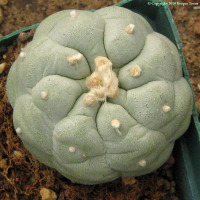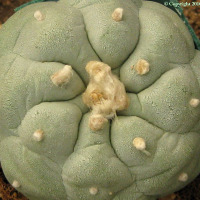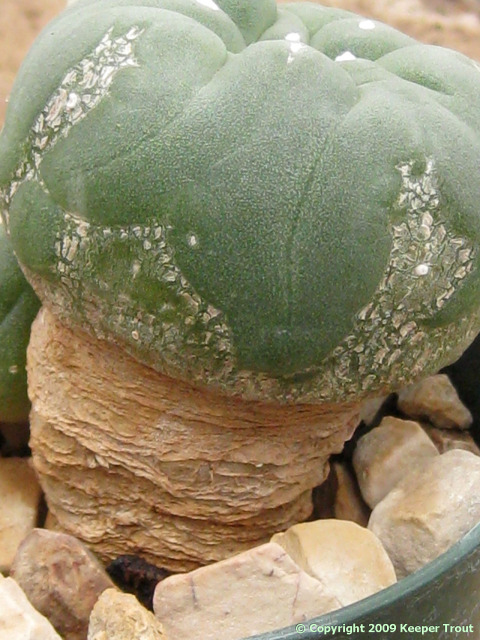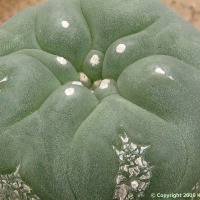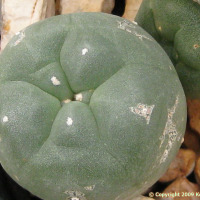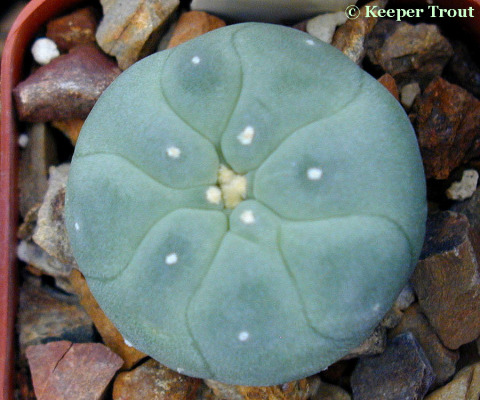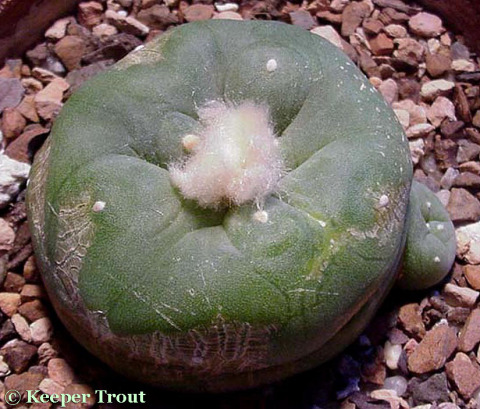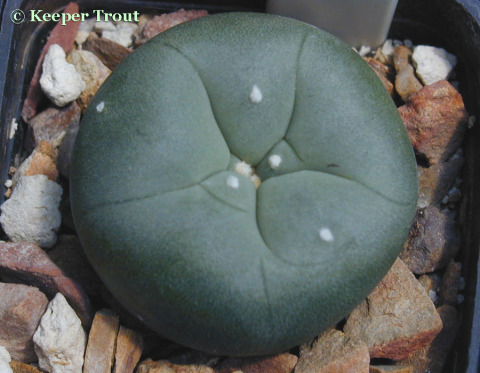Lophophora diffusa (Croizat) Bravo
Léon Camille Marius Croizat (1944) Desert Plant Life, 16: 44. as Lophophora echinata var. diffusa.
Helia Bravo Hollis (1967) Cactaceas y Suculentas Mexicanas, 12: 13, as Lophophora diffusa.
Mescaline has been reported to be present in trace amounts. It has not been detectable by all researchers. (Those should not be viewed as being conflicting accounts but rather they should be understood as having results differing based on the cacti they analyzed. There is no reason to believe that any of the results were not valid.)
Origin: Endemic Mexican cactus now found only in two relatively small areas such as around Peňa Blanca north of Vizarrón in the Mexican state of Querétaro [around 1,500 meters (5,000 feet) in elevation] and in another small population closer to Vizarrón. It is known to have formerly had more occurrences that now appear to be gone.
Habitat: Lophophora diffusa‘s habitat is stony limestone hillsides covered by thorny plants with thickets of both thorny and unarmed microphyllous shrubs (many of which serve as nurse plants).
Names encountered in horticulture: difyusa, 翠冠玉, 仙人掌
One ould like to suppose this species had a nice start in botany. A major problem began when Léon Croizat inexplicably decided diffusa should be placed as a variety of Lophophora echinata. We will return to this again in a moment but the peculiar amount of confusion surrounding the entry of this species into botany needs to at least be mentioned.
Lophophora echinata Croiz. diffusa var. nov.
A var. typica podariis latioribus quam longis inter se arcte confluentibus, obscure conicis differt.
Typus: “Lophophora Williamsii” sensu Bravo, Cact. Mex. 378 fig. 201,
1937, excl. descr. syn. omn.
Croizat 1944.
One can only puzzle as to what Croizat was thinking.
I suspect that many of Backeberg’s problems originated with his use of Croizat’s descriptions as a basis for his classification within this genus (apparently not caring that some was based on Rouhier) and that this was largely the source for the confusion surrounding echinata as it is now known in horticulture.
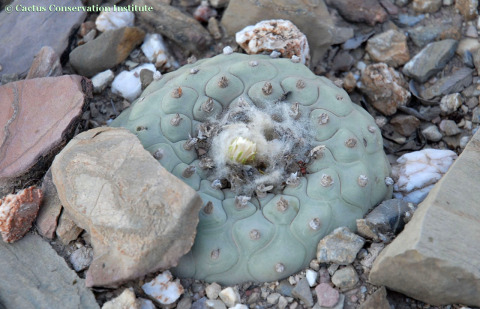 Habitat photos from Cactus Conservation;
Habitat photos from Cactus Conservation;
reproduced here with their permission
Description of Lophophora diffusa
Body is yellowish-green [Anderson 1980, Schultes & Hofmann 1980; This is the only color I have observed in plants raised from seed], Grey-green, sometimes rather yellowish green. [Schultes & Hofmann 1992: p. 48], always with a grayish glaucous haze on the surface. Chalky green to pale bluish-green according to Lamb & Lamb 1978 (which raises questions in my mind about this and possible contribution from the European echinata/Lewinii intersection with Lophophora diffusa),
Normally solitary, they can form large clumps.
Plants are soft, succulent, often globular in shape, somewhat flattened, 2-7 cm. high, and 5-12 cm. in diameter.
They are usually lack well defined ribs and furrows, podaria are rarely elevated but are broad and flat; especially so on larger old plants. (Some Japanese cultivars such as “Big Breast” have been selectively developed for sake of having large and prominent podaria.) In contrast to the more regular distribution seen in L. williamsii, the tufts of hair are spread unequally on the prominent podaria. Old plants may form up to 13 very sinuous low spiral ribs sometimes with well defined tubercles in the sense commonly regarded as being for “decipiens”.
Areoles are circular and small, set 1-2 cm. apart, ranging from 2 to 3 mm in diameter, bearing a small tuft of short white or grayish white hairs.
Flowers are said to be twice the size of williamsii (by Lamb & Lamb 1978); and by Schultes & Hofmann (1992) (p. 48) to be “much larger” than those of williamsii. Flowers: 1.3-2.2 cm. in diameter, 1.3-2.4 cm. long; Anderson (1980) page 187; 2.5 cm in length and 1.3 to 2.2 cm in diameter, Bravo
Flowers are white or faintly pink but sometimes appearing yellowish-white (Anderson (1980) page 187); white or yellow (Habermann 1975); pale pink and occasionally almost a pale magenta. (Lamb & Lamb 1978); slightly pinkish-white and sometimes yellowish white (Bravo 1991).
Hypanthium is naked and green; greenish-white receptacle tube has scales that are 2 to 6 mm in length,
Outer perianth segments are 1-2 mm. broad and green; the inner perianth segments are 2-2.5 mm, lanceolate, acuminate; outer segments of the perianth of 6 to 10 mm in length and 1 to 2 mm in width, lanceolate, acuminate, with the margin entire, white with a greenish midline ; the inner perianth segments arranged in two series, linear, with the apex ± rounded, with the margin entire, 10 mm in length and 2 to 2.5 mm in width, color is a slightly pinkish white and sometimes yellowish-white;
White filaments with yellow anthers;
White style with 5 white stigma lobes.
Claviform fruit is naked, 15 to 20 mm in length and about 8 mm in diameter, of a light pink color becoming red (according to Bravo 1971), a light pink-purple color turning brown at maturity (according to Bravo 1991), whereas a white fruit is commonly reported by growers. Bohata et al 2005 commented that the fruit of L. diffusa can range from white to a dark pink. Kada & Koehres have both comment on L. diffusa typically producing many more seeds per fruit than L. williamsii.
Flowering from May through June according to Bravo 1991.
Pyriform seed, from 1 to 1.5 mm in length, with testa tuberculate.
Pollen is 0-6 colpate, 26.1-48.5 mm in diameter. Pollen is much less variable than L. williamsii and shows a higher percentage of tricolpate grains.
Description adapted from Anderson 1980, Bravo 1967, 1978 & 1991, and Schultes & Hofmann 1980 & 1992
See (all have photograph):
Anderson 1980: page 187
Bravo 1967, 1978 & 199
Grym 1997 & 2014
Innes & Glass 1991: page 150
Lamb & Lamb 1978: page 1297
Schultes & Hofmann 1980: page 221; 1992: page 48
See also:
Bravo 1967 & 1978
Bruhn 1976
and Boke & Anderson 1970
and Anderson 1966.
Useful search terms for locating additional imagery:
翠冠玉(Lophophora diffusa)
翠冠玉缀化(Lophophora diffusa var. cristata)
Associations: According to Bravo, Lophophora diffusa grows at the base of and in the shade of such shrubs as creosote bush (Larrea tridentata), cenizo (Leucophyllum texanum), cat’s-claw (Mimosa biuncifera), huisache (Acacia farnesiana) and other species of the arid highlands. (Bravo 1991)
- Mesa Garden #548
- Mesa Garden #548
A more detailed listing of associated species does not appear to have been created yet but the following can be observed in Cactus Conservation Institute photographs online:
Astrophytum ornatum
Echinocactus platyacanthus
Larrea tridentata
Mammillaria compressa
Mammillaria spp.
Myrtillocactus geometrizans
Neolloydia conoidea
Opuntia leptocaulis
Prosopis sp.
Strombocactus disciformis
Tiquilia spp.
& additional assorted cactus species
Additional species showing up in field collection notes at Ralph Martin’s database:
Coryphantha sp.
Mammillaria parkinsonii
Echinocereus pentalophus
Ferocactus histrix
Thelocactus leucacanthus var. schmollii
There seems to be no common name in the West to distinguish this from peyote. It is usually called peyote. Early literature sometimes referred to it as Anhalonium williamsii and much has been made of this by Holmstedt & Bruhn as it involved some of the early chemical and ethnobotanical accounts. See more in an analysis concerning what they refer to as “The Lewinii Controversy.”
Heffter had apparently acquired Lophophora diffusa as peyote so noted Anhalonium williamsii during analysis to be chemically distinct from Anhalonium lewinii as he could only isolate pellotine from it. It seems probable that his A. lewinii was the dried material Parke-Davis had sent to Lewin. (From the latter Heffter isolated mescaline and several other alkaloids) Kauder and Lewin both also recognized there were two species based on chemical differences although only Heffter included illustrations. This topic is discussed in more detail in the comments on “Lewinii” and in the entry for L. williamsii (under its reported chemistry).
Suggestions for more in depth analysis and revision of the genus went largely unheeded until fairly recently. Even as late as 1959 the Bulletin on Narcotics insisted on referring to peyote as a monotypic genus consisting of only Echinocactus williamsii (Anhalonium williamsii), rejecting the name Lophophora entirely (Echinocactus williamsii was described by Lemaire 54 years prior to Coulter’s separation of the genus Lophophora). They interestingly dismissed Anhalonium lewinii as a pseudo “new species” [Note 3].
Schumann 1898 felt there was only one species and that what Heffter referred to as Anhalonium williamsii (the plants which contained primarily pellotine) were simply a local chemical form of Echinocactus williamsii (Echinocactus williamsii a pellotinica)
Britton & Rose similarly also believed there was only one species; Lophophora williamsii.
Despite their visible differences and observable differences there is still occasionally a lack of agreement between those who consider this a separate species (now this is most modern authorities) and those who consider this a variety of L. williamsii (a steadily decreasing minority).
Reported analysis of Lophophora diffusa
Todd 1969 Lloydia 32 (3): 395-398:
Plants collected 26 June 1967 near Vizarrón.
Pellotine
Lophophorine
Anhalamine
Anhalonidine (traces)
Mescaline (traces)
Anhalamine was only in above ground portions while the other four alkaloids were equally present in root & above ground portions. Todd’s work was entirely based on tlc.
Bruhn & Holmstedt 1974 were unable to identify mescaline but observed N-Methylmescaline to be present in trace amounts in the nonphenolic fraction (using GLC-MS). There were other alkaloids present that were at levels too low to identify.
One of these turned out to be O-Methylpellotine and they published the details in a subsequent paper. See below.
In fresh whole plants, they found a total alkaloid content of 0.90% of which 98% was phenolic and 2% was nonphenolic.
Pellotine was identified as major alkaloid in phenolic fraction. Small amounts of anhalidine and trace amounts of both anhalonidine and hordenine were observed in the phenolic fraction as well using tlc and gc. They did not observe anhalamine. Anhalamine and mescaline, if present, were at trace levels too low for them to detect. They made no mention of lophophorine.
Plants were collected north of Vizarrón on 29 June 1971 by Jan G. Bruhn and Hernando Sánchez-Mejorada.Herbarium voucher was made.
Bruhn & Agurell 1975 identified O-Methylpellotine as a trace component of L. diffusa.
They were unable to isolate it due to low concentration present. [They recovered 10 mg. of non-phenolic alkaloids from 500 grams of fresh plants.]
Identified by tlc, GC and GLC-MS with a known reference sample.
Herbarium voucher was made.
Schultes & Hofmann 1980: p. 221
Principle alkaloid is pellotine (over 90% of total alkaloid).
Produces mainly phenolic tetrahydroisoquinolines and only very low amounts of non-phenolic alkaloids (2% of total)

